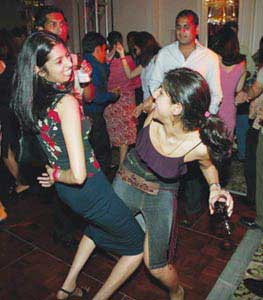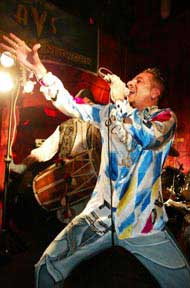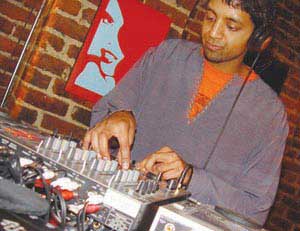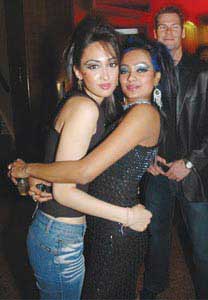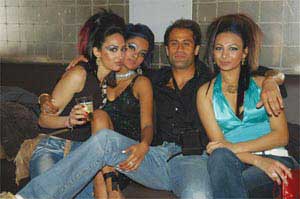Arts
It's A Party

The desi party scene is part rebellious statement by young South Asians proclaiming their own thing.
|
Across America, a thriving culture of desi parties has young South Asians pulsating, gyrating and lilting to the latest hiphop and bhangra beats.
The young desi party movement is sans the influence of the previous generation, nor is it cloned from the western world the new generation inhabits. The desi parties are forums for socialization and networking, yes. They are, equally, an openly rebellious statement by young South Asians proclaiming it as their own thing. Although many South Asians trace their family tree three generations in North America, the desi party scene is relatively new, under a decade old. Among the first people to catch whiff of the emerging phenomenon were Zeeshan Khan, 28, and Hemant Patel, 26. Both come from a traditional information technology background and host Desiparty.com, a website that doubles as a huge internet advertising corkboard for desi parties, which are happening all over the world. In mid-April 2005, they celebrated 11 successful years in the desi party advertising business. Patel says: “The site was launched in 1994 in hopes to develop a website to publicize and review the emerging ‘desi’ nightlife. Nearly a year after the launch, it had already grown to be an indispensable resource to the desi crowd. It started off being once a month event, to weekly – advertisings desi events all over US. In a given year, the Desiparty.com party list contains over 5,000 events in United States alone.”
On any given day, their site averages 94,000 hits, or just under 3 million monthly. There is clearly a huge market and demand for information about desi parties. Young South Asians want to know what’s going on where. Desi parties have proven not to be just another passing fad, but, rather, a staple social outlet for the youth in the South Asian community. The Desiparty.com founders relate the different shifts in the desi party scene over the years and in the way parties are marketed: “In the past, Desiparty.com did not focus too much on marketing, because the name itself was a driving force. I believe that many South-Asians who were seeking some sort of social outlet had heard of us. If they hadn’t, we weren’t too hard to find. Marketing for us wasn’t a priority since the hundreds of promoters and organizations we worked with usually cross-promoted our brand giving us additional exposure globally. Today, however, we gain grounds through various media sources who contribute to our success with exclusive cross-promotions.” The advertising for the online marketing flyers for South Asian parties is often created by Kunal Aggarwal’s company Kage Productions. As such, he is in touch with the ground floor of the party machine, providing party-hungry South Asians with information on the venue, cover-charges and other details of the events.
However, even though Aggarwal’s work screams out on numerous party listings at Desiparty.com and other similar sites, you are unlikely to find him anywhere on the dance floor: “Most of the flyers I work on are typically for clients on the east coast. I don’t think I’ve ever been to any of those parties in those cities.” He doesn’t have to. He sticks to a central formula in every flyer he designs, regardless of the city or promoter he’s working for: target the audience into the “18 plus” crowd and the “21 plus” crowd. Aggarwal says: “Younger people are drawn to larger venues, drink specials and loud music. If you are promoting to an older crowd, the flyer needs to be a bit more mature (typically no ‘skanky’ girls as the main imagery). The trend with promoting to an 18+ age group is typically to advertise the party as a big blowout and hype the drinks, DJs, and venue size. I’ve noticed that as a promoter, to draw in a older crowd, you usually need to promote the uniqueness of the venue, rather than the size and also focus on something different, such as well known performers, DJ’s, and so on. I think the flyer design plays a very big part in persuading people to come. “ Saurin Shah, a consultant in his mid-20s and a regular at desi parties for years, has been though both stages of the desi party scene: “I remember most of the high school parties being free of alcohol, but it was starting to come into the picture. In college, parties got a little intense. More alcohol, for example, was the strongest driving factor with my friends wanting to come and meet people at a desi party. I’ve had the best time at parties among 20 somethings, an older crowd. These parties are usually pretty tame and well organized. The atmosphere ranges from wild to mellow, depending on when and where you go. People are more mature, so there’s less drama. It’s also a good place to network with other South Asians, which can be quite difficult otherwise.”
Living in Charlotte, North Carolina, which has a small South Asian population, Shah has a commanding, panoramic view, both good and bad, from sampling the desi party scene during his various travels in major South Asian hubs where the majority of the parties are held, Desi parties don’t have many variables in his experience, in the way people act, the music, or even the level of enjoyment he experiences: “I don’t think there’s much difference. It all depends on the crowd the party is being marketed to. For example, the triangle area (Raleigh, Chapel Hill, Durham, N.C) is full of desi college students, so the parties there are different than the ones in New York City or Chicago. You may also hear a few more bhangara remixes at parties in New York City and Toronto due to the Punjabi population there. I’ve only been to a couple of parties in Toronto and in my limited experience, I found the parties there to be tame compared to the U.S. standards.” But, no matter the city, the disc jockey makes or breaks any desi party, regardless of the age group it targets. The DJ controls every play, song and groove and thus the tempo of the dance floor.
One of the top players in this market is DJ Karma (real name Hardeep Singh). Over the years (keep in mind he’s only 26), Singh has earned his place as a respected and experienced professional on the desi party scene. How did he get there so quickly? Singh says he was exposed to his first desi party at age 15 and it all just snapped in place. “I was immediately attracted to the musical aspect of the party. Rather then trying to pick up girls, I was more interested in what the DJ was doing. I spent my whole night just watching him and I knew then it was something I had to try out. On my 16th birthday my older brother bought me two turntables and a mixer. From that day on, I spent about 8 months just practicing everyday after school. I first started DJing publicly at non-desi club, house parties for few months and then moved into the desi world, where I’ve been ever since.” DJing is less of a science and more of an art for Singh. “I’ve always been about one thing – the dance floor. I’ll play anything that keeps the party goers happy and makes people dance. A good DJ should be able to adapt to any situation.” As the proverbial captain of his party, the most important thing he has to do is to be track music trends, which change constantly – from the new Bollywood song, to the hottest remix from Bally Sagoo.
During his career, he’s gone from more up-tempo stuff (house and Hindi house remixes), which were popular a few years ago, to the current popular trend, uptempo hiphop and bhangra. Janaka Selekta and Maneesh (The Twister) Kenia, cofounders of Dhamaal, a highly successful electronic artist collective centered around South Asian culture, take a different slant on the music, visuals and art that is represented at their events. Says Selekta: “Dhamaal is an inclusive desi party, of sorts, that is not only attended by South Asians, but draws from the sprawling underground artist scene of San Francisco. This has created a multicultural quilt of faces that are there to dance to both traditional live Indian and Pakistani folk music performed by starlet artists like Sukhawat Ali Khan and Riffat Sultana and to bounce to heavy breakbeats, dub and drum bass music with live tabla and skratchin. DJ music with live percussion has been a staple of our evolution. Where we are today is on taking those elements and making our own music. We are on our second original music release now and our songs are regularly played in the UK on BBC Radio 1.”
Dhamaal may be a poster child for the future of the desi party scene, because it caters to a more mainstream audience than most traditional desi parties. It currently has bases in San Francisco and New York. “Dhamaal has all the elements you would have at any successful party. We take great pride in what we do and it shows. Our last event ‘Worldly’ drew 1,600 discerning people. This is not your average big venue partier, but people that have been at our shows over the past six years and know that we put on events that are seldom topped in San Fransisco. We are also respectful of the tradition that this music stems from. Shabi Farooq, Ferhan Qureshi and Parag Chordia are all disciples of Ustads like Zakir Hussein, Tari Khan, Das Gupta. They hold the DJs to high standard,” Selekta says. Dhruva Ganesan, resident music producer/DJ for Dhamaal, finds that most common labels associated with desi parties don’t necessarily fit their vibe. “There is such deep crossover between different cultures. A couple of our crew members are not desi and they are just as important as anyone else. Similarly, since the crowd is very mixed, calling it a desi party would exclude many of the people that help shape the Dhamaal vibe, both from the creative and receiving sides. Also, there is so much stylistic crossover. We drop heavy beats that come from all kinds of places and don’t necessarily fit the desi tag. South Asian elements are definitely a strong part of our sound and general aesthetic, but they don’t define the entire package.”
Selekta, Kenia and Ganesan, who quit lucrative jobs to pursue music full time, are looking at the future of their organization to broaden the understanding of South Asian music and electronic music by South Asians. By doing so, they present a new and exciting facet of the desi party scene, where a desi party is more than a longing fascination or a weekend gig, but something that can develop into an enduring and successful career. They have an urge to keep growing and developing as producers, performers, as well as keeping the desi music scene strong and unique. They’ve already toured all over the world and have managed to invite well-known musicians and bands to appear at their events. “We are looking at an Indian tour in December and in the next month alone we are playing in New York City, Los Angeles, San Diego, Washington, DC, and UK. We’re covering a lot of ground and pushing full steam ahead. The major focus for us is on making good music and on building positive bridges between communities,” Ganesan says. The Dhamaal crew has two locations in San Francisco where they draw crowds in two of the city’s biggest and most coveted spots. In New York their presence is growing as well and represents a sort of branching out that has come with their popularity on the west coast. “The rise of Dhamaal New York City is a big branch in the organic growth and evolution of Dhamaal. Like the west coast headquarters, the NYC branch will be collaborating with break-beat crews and bridging the gap between ancient South Asian aesthetics and hyper-charged future sounds. There is a parallelism of vibe that we’re creating on both coasts,” Ganesan says.
The regulars reject that as an unfair and inaccurate rap attached to the desi party scene. Says Georgia based Shilvi Gandhi, 24, a familiar face at desi parties since high school: “I think to say a desi party is a ‘meat-market’ is unfair. In many cities, it’s difficult to meet other Indian people. For many Indian youths, college is their first exposure to other Indians. Most of our parents encourage us to date and marry an Indian, and these desi parties provide an opportunity to meet other Indian people. Just because a desi party tailors to a desi crowd, does not make it a meat-market.” Her sentiments echo another common theme: desi parties are just counterparts of what other races and minority groups have had for much longer. Says Gandhi: “Almost every race has their own mixers and parties. In college, fraternities and sororities attract a mainly white crowd. Asians, Latinos and, now, desis all have their own parties. I used to attend these parties in high school to meet other Indian people. I think every immigrant has some sort of an identity crisis, but I wouldn’t say a desi party is trying to make up for any insecurity a person may be feeling.” Perhaps some of the negative connotation attached to desi parties stems from the fact that the parties go against the grain of what generally conservative South Asian families teach their kids about the opposite sex, drinking and just partying in general. Gandhi had a more liberal upbringing and says her relationship with her parents is relatively open. They recognize that the parties are an outlet for getting to know other Indians. She says, “Even in high school they were aware of these desi parties. I think they know that it consists of young people, many times single people, who are drinking and dancing. I do believe many parents don’t know about the amount of drinking that goes on at these parties. But again, it’s not fair to pinpoint the desi parties because every person in their late teens through early 30s, regardless of race, drinks and goes out. Desi parties are just catering to a different crowd.” Shah, whose upbringing was more conservative, also insists that the meat market phenomenon isn’t exclusive to desi parties. “When a group of people with certain characteristics get together, regardless of their ethnicity, this is bound to happen. I’ve seen this at Arab, Latin and Asian parties as well. I’ve told my parents a little bit about the party scene. I think they find out a little more on their own by watching TV and from their friends. And the rest they will know when they read this article,” he jokes. “I think they have a pretty good idea of what goes on. That’s probably why they don’t talk about it. The whole desi party scene has gotten a bad rap. I mean let’s face it – most people don’t go to these parties to fulfill their parents’ dreams.” That just may be it. It’s not about the parents’ dreams. It’s about the youth, the South Asian youth and their own way of celebrating, in their own space and in their own way. There is a certain sense of pride in feeling that it’s their own thing. The pride could be manifested via a crowded club in New York, with loud Bollywood-remixed music by DJ Karma, or in San Francisco’s top club with Ganesan’s Asian Drum-and-Bass track playing hypnotically in the background. A random South Asian, someone, anyone – it could be Shah or Gandhi – doesn’t really care about the labels put on the desi party they are at, or what their parents are thinking, which may or may not be true about the evening ahead of them. They don’t even care if Aggarwal’s flyer, which they viewed on Desiclub.com early in the night, lived up to the hype it promised. When it comes down to it, it’s really just about one thing; quickly getting lost in the space, the music, the people – all the while finding a unique connection to being a young South Asian on self-prescribed terms. |

